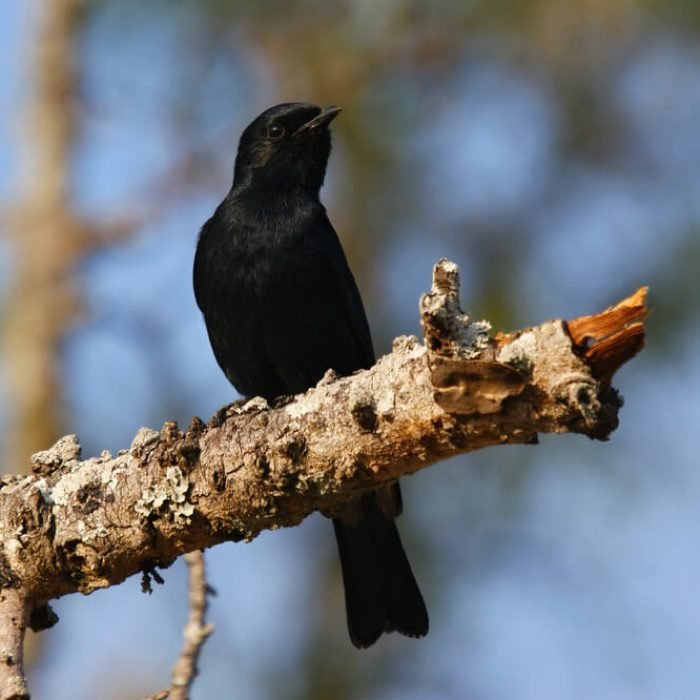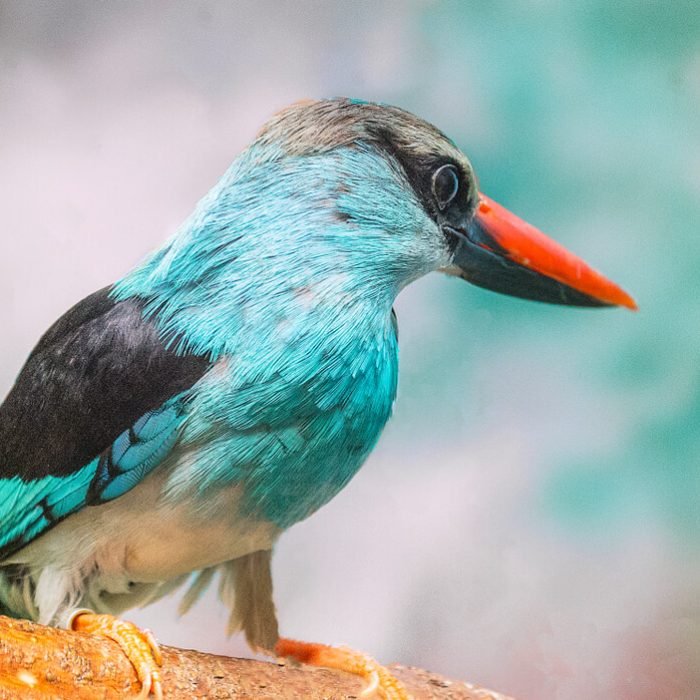Wattled Crane
- Grus carunculata
- IUCN Status: Vulnerable
- Trend: decreasing

General Information
Wattled crane (Grus carunculata) is a large, threatened species of crane found in wetlands and grasslands of eastern and southern Africa, ranging from Ethiopia to South Africa.
Description
The back and wings are ashy gray. The feathered portion of the head is dark slate gray above the eyes and on the crown, but is otherwise white, including the wattles, which are almost fully feathered and hang down from under the upper throat. The breast, primaries, secondaries, and tail coverts are black. The secondaries are long and nearly reach the ground. The upper breast and neck are white all the way to the face. The skin in front of the eye extending to the base of the beak and tip of the wattles is red and bare of feathers and covered by small round wart-like bumps. Wattled cranes have long bills and black legs and toes. Males and females are virtually indistinguishable, although males tend to be slightly larger. Juveniles have tawny body plumage, lack the bare skin on the face, and have less prominent wattles. The generation length (in years) is 13.
Fun Facts
More than half of the world’s wattled cranes occur in Zambia. They are also the largest and tallest flying bird native to Africa.
Ecology and Behaviour
The wattled crane exhibits some seasonal movements, though these patterns remain poorly understood. Rather than following strict temperature-related migrations, their movements appear primarily driven by local water conditions. During flood events, populations can swell dramatically from nearly absent to as many as 3,000 individuals concentrated in favorable areas. This fluid distribution suggests opportunistic habitat selection rather than fixed migratory behavior, though researchers have documented some seasonal altitudinal movements between Mozambique’s high and low plateaus.
Diet
All cranes are omnivorous. The principal food of the wattled crane is mainly aquatic eating the tubers and rhizomes of submerged sedges and water lilies. It is one of the more herbivorous of extant cranes. The other primary portion of the diet consists of aquatic insects. They will supplement the diet with snails, amphibians and snakes when the opportunity arises. Roughly 90% of foraging done by this species occurs in shallow waters. They typically forage by digging vigorously with their bill into the muddy soil. On occasion, it will eat grain and grass seed as well, but does so much less often than the other three African crane species.
Reproduction
Outside breeding season, these cranes often gather in loose flocks, typically numbering around 10 birds but sometimes forming larger groups of up to 89 individuals. While they occasionally encounter crowned cranes, significant interaction proves uncommon due to differing foraging strategies. Wattled cranes more frequently associate with two species sharing their wetland habitat preferences – the lechwe antelope and spur-winged goose, though the latter tends to occupy slightly deeper waters. Their substantial size provides adult wattled cranes with considerable protection from predators, though jackals may occasionally prey on vulnerable chicks.
Breeding typically begins in April, with pairs constructing simple nests of trampled grasses along marsh edges, sometimes repurposing abandoned spur-winged goose nests. Egg-laying follows about three weeks after nest preparation, with the species producing the smallest average clutch size of any crane at just 1.6 eggs. Even when two eggs are laid, usually only one chick survives to hatching or fledging. The incubation period lasts an exceptionally long 33-36 days – the longest among cranes – with both parents sharing duties. After hatching, the parents continue their cooperative care, taking turns feeding the chick for about 80 days until it begins foraging alongside them. The species shows particularly protective parenting behaviors, with adults immediately shepherding their young into tall grasses at any sign of danger. Wattled cranes also demonstrate the longest fledging period of any crane species at 100-150 days, with juveniles typically remaining with their parents for nearly a full year before joining flocks of unrelated young birds.
Conservation
It is listed by the International Union for Conservation of Nature (IUCN) as, ” Vulnerable”.
Distribution and Habitat
Wattled cranes inhabit fairly inaccessible wetlands under most conditions. It requires shallow marsh-like habitats with a good deal of sedge-based vegetation.
They occur in eleven countries in eastern and southern Africa, including an isolated population in the Ethiopia Highlands. More than half of the world’s wattled cranes occur in Zambia, but the single largest concentration occurs in the Okavango Delta of Botswana.
Interaction with Humans
Destruction, alteration, and degradation of wetland habitats constitute the most significant threats to the wattled crane, perhaps one of the most habitat sensitive of all cranes. Hydroelectric power projects and other water development have caused fundamental changes in the species expansive floodplain habitats, and their most important food source Eleocharis spp. Human and livestock disturbance, powerline collisions, mass aerial spraying of tsetse flies, and illegal collection of eggs, chicks and adults for food are also significant threats to wattled cranes throughout their range.














